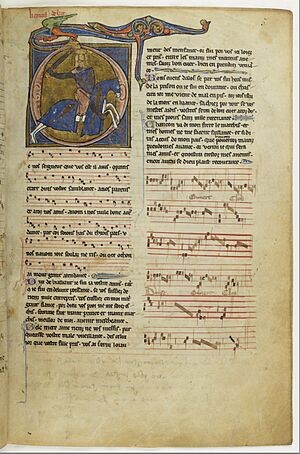Trouvère facts for kids
A trouvère (say "troo-VAIR") was a special kind of poet and musician from Northern France during the Middle Ages. They were like the rock stars of their time, creating and performing their own songs and poems. The word "trouvère" comes from an older French word that means "to find" or "to invent," because they invented new songs and stories.
Trouvères were similar to the trobadors (say "tro-ba-DOR") from Southern France. Both groups wrote and sang beautiful songs, but trouvères used the dialects of Northern France, while trobadors used a language called Old Occitan. One of the first known trouvères was Chrétien de Troyes, who lived in the late 1100s. Trouvères were popular until about the year 1300. We still have over 2,000 of their poems today, and most of them even have their original melodies!
Contents
Who Were the Trouvères?
When you think of a medieval musician, you might imagine someone traveling from town to town with a lute (a stringed instrument) on their back. These traveling performers were called jongleurs or minstrels. They were professional entertainers and usually had a lower social status.
Trouvères, however, were often different. Many of them were from noble families or were supported by rich lords and ladies. For them, making music and poetry was a part of their fancy court life, not just a job. They were poets and composers who created art for their own enjoyment and for the people around them. Sometimes, though, the lines between these groups could get a bit blurry.
What Did They Sing About?
The songs of the trouvères tell us a lot about their society. Many songs were about "courtly love"—a special kind of love where a knight would admire a noble lady from afar. These songs were often very romantic and respectful. Trouvères also wrote about religious devotion.
But not all songs were serious! Some were more fun and down-to-earth. Other popular types of songs included:
- Jeu-partis: These were debate songs where two or more trouvères would argue about a topic.
- Pastourelles: Songs about a knight meeting a shepherdess.
- Dance songs: Songs meant for dancing.
- Chansons de femme: Songs written from a woman's point of view.
A musical expert from the 1300s, Johannes de Grocheio, believed that the most important trouvère songs, called grand chants, could inspire kings and nobles to be brave and generous. He said these songs were sung in front of important people to encourage them to do great things.
How Did Their Music Sound?
Most trouvère music was sung with just one melody line, meaning there were no harmonies or other parts playing at the same time. This is called monophonic music. The words were usually sung simply, with only one or a few notes for each syllable.
We don't know exactly how fast or slow the songs were meant to be sung, because the rhythm wasn't written down for most of them. Also, the songs don't say which instruments to use. However, we know from drawings and stories that instruments were common back then. So, trouvère songs were probably sometimes performed with instruments, but they could also be sung without any music at all.
Most trouvère songs used a strophic structure. This means they had one melody that was repeated for all the different verses of the song. Sometimes, a short line or two would be repeated in each verse, like a chorus. These repeated parts were even used in different songs, connecting them together.
Women Trouvères
For a long time, people thought there were no women trouvères. This is because we don't have many songs where a woman clearly says, "I wrote this." However, we do have some old books where women are named as the authors in the notes or lists of songs. Also, some debate poems (jeux partis) include a female voice, whether named or not. Many other songs are written from a woman's perspective, and these might have been written by women too.
Since the 1980s, experts have generally agreed that women trouvères did exist. They have been working to find anonymous songs that might have been composed by women, looking at the lyrics and other clues. The word troveresse (say "tro-ver-ESS") was sometimes used for women trouvères. It means "she who composes or invents."
Here are some of the women trouvères known by name or title:
- Blanche of Castile (1188–1252)
- Dame de la Chaucie
- Dame de Gosnai
- Gertrude, Duchess of Lorraine (1205–1225)
- Lorete
- Margot
- Maroie de Diergnau
- Sainte des Prez
Famous Trouvères
There were many trouvères, and we know the names of 256 men who were trouvères. Here is a partial list of some of the most well-known:
- Adam de la Halle (around 1240–1288)
- Adenet Le Roi (around 1240–1300)
- Blondel de Nesle (active around 1175–1210)
- Chastelain de Couci (active around 1170–1203)
- Chrétien de Troyes (active in the 1160s–1180s)
- Colin Muset (active around 1200–1250)
- Conon de Béthune (active around 1180–1220)
- Gace Brulé (around 1159–after 1212)
- Gautier de Coincy (1177/8–1236)
- Guiot de Dijon (active around 1200–1230)
- Jehan Bretel (around 1200–1272)
- Moniot d'Arras (active around 1250–1275)
- Richard I of England (yes, the king!)
- Rutebeuf
- Theobald I of Navarre (1201–1253)
Trouvère Songbooks
The songs of the trouvères were collected in special books called chansonniers. These books are like ancient songbooks or poetry collections. Each chansonnier is given a special letter, called a sigla, to help scholars identify them. Here are some of the important chansonniers:
- A — The Chansonnier d'Arras
- M — The Chansonnier du Roi (King's Songbook)
- O — The Chansonnier Cangé
- T — The Chansonnier de Noailles
- U — The Chansonnier St-Germain-des-Prés
- X — The Chansonnier de Clairambault
See also


